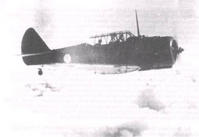


RAAF Meteorological Service
Foreword
Introduction
Chapter 1: The Weather Factor in Warfare
Chapter 2: Establishing and Developing the RAAF Directorate of Met. Services (D.Met.S)
Chapter 3: Recruiting and Training of Personnel
Chapter 4: Meteorology in Aviation
Chapter 5: The Met. Retreating
Chapter 6: The Met. Advancing
The Coral Sea Battle—May 1942
The Battle of Milne Bay—24 August to 8 September, 1942
The Bismarck Sea Battle—1 March 1943
Chapter 7: The Met With the Army and the Navy
Chapter 8: Divisional Offices of the Bureau of Meteorology During the War
Chapter 9: Research and Instrumental Development
Chapter 10: The End, Aftermath, and Beyond
Appendix 1
Appendix 2
Appendix 3
Appendix 4
References
Index
Search
Help
Contact us

The Bismarck Sea Battle—1 March 1943 (continued)
In 1944, as the front line receded northward from Australia, the roaring days for the meteorological section at general headquarters were over. The section was nevertheless kept busy, developing the skill of weather analysis, and researching the ever-challenging tropical weather.Keith Hannay later recollected events at Darwin during his term in charge of the meteorological section there, taking over from Flight-Lieutenant John Lillywhite, who had been Acting-Area Meteorological Officer since October 1943. The Australian Regional Broadcasting Centre was at Birdum. Forecasting stations had been set up at Gove, Truscott and Fenton airfields. The operational requirements were forecasts for and advices from the Netherlands East Indies area for regular reconnaissance and strikes of various types, and for aerial photography. The normal transit and civilian requirements continued to be met. Fleet messages and Fleet forecasts were issued to the Navy, and, during 1944, to a mobile Meteorological Flight with the Army.[74]

There were no more attacks on the mainland of Australia in this later period, 1944–45, but there were some enemy reconnaissance missions. A photographic Japanese Dinah aircraft was shot down by Spitfires in full view of a Meteorological Assistant at Truscott on one occasion.
The Japanese air-to-ground secret code had been broken, and weather reports were gleaned as a result. These reports were not given out to staff generally. Squadron-Leader Arch Shields described to me how he used to plot reports from the Japanese on a private chart, and how helpful he found them to be. Shields later succeeded Squadron-Leader Harry Ashton as OIC, Met. at No. 1 Tactical Air Force. He commented on the good sense of the Americans. Although they had a weather section of their own, most of the US aircrews came to the RAAF meteorological section for advice and briefing. Finally, the American commander said, 'Most of our boys seem to come to you. Why don't you take over the whole caboose?'—and so, said Arch Shields, 'we took over 11 US weather personnel'[75]
People in Bright Sparcs - Ashton, Henry Tamblyn (Harry); Hannay, Alexander Keith (Keith); Lillywhite, John Wilson; Shields, Archibald John
 |
Bureau of Meteorology |  |
© Online Edition Australian Science and Technology Heritage Centre and Bureau of Meteorology 2001
Published by Australian Science and Technology Heritage Centre, using the Web Academic Resource Publisher
http://www.austehc.unimelb.edu.au/fam/0292.html